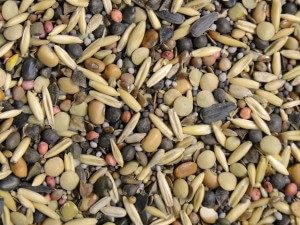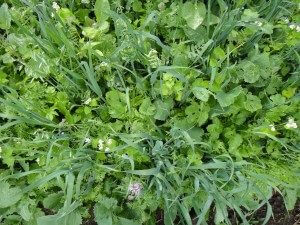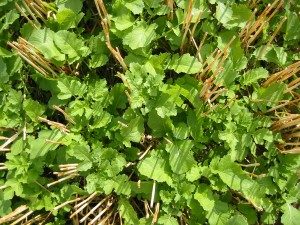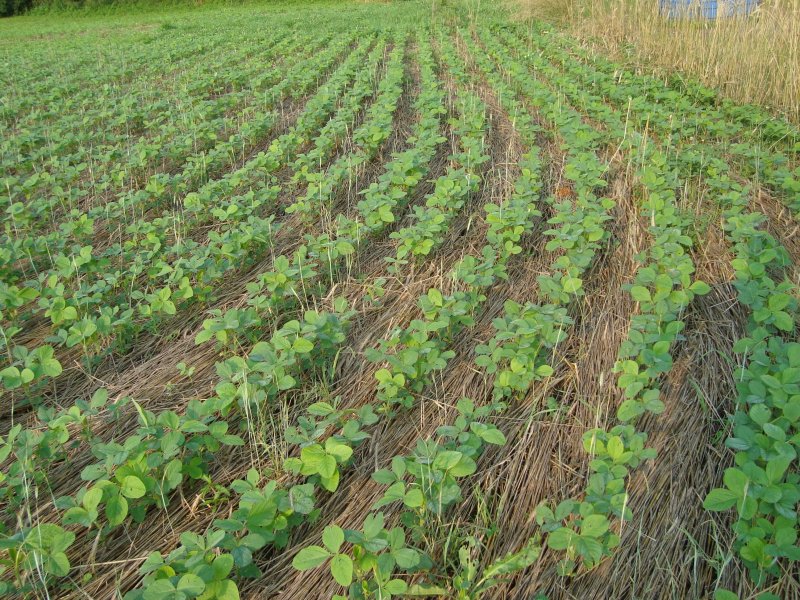
Research thus far has consistently found that cover crop polycultures are not necessarily better than cover crop monocultures. This is now reaffirmed by a large study, done in Pennsylvania (Finney et al. 2016). The study had 18 treatments replicated four times (these studies are a lot of work). Eight species were grown as monocultures. Seven 4-species mixes and two 8-species mixes were the polyculture treatments, and they included a no cover crop check treatment. All this was planted in August, for two years (different field each year).
The big idea behind cover crop mixtures is that the increased biodiversity will result in increased productivity, increased ecosystem services, or both. The Finney group tested both hypotheses. They found that the mixtures produced less biomass than the best monocultures (here, canola and cereal rye). They also found that mixtures did not provide increased ecosystem services (here, weed control, nitrogen scavenging, nitrogen storage, and effect on following crop) over the best monocultures. These findings are related. Finney et al. found that most of the ecosystem services which we want cover crops to provide are related to biomass production. Because a few of the monocultures produced the most biomass, they also provided more services. From this, they concluded that “a mixture may not be necessary” and “a single cover crop species may be sufficient and more economical than a mixture.” (I attended several sessions on cover crop mixtures at this year’s meeting of the Agronomy, Crop Science and Soil Science Societies, and did not hear any results that went against these findings.)
Mixtures do have one advantage, they can provide more services (multifunctionality) than a monoculture. However, in mixtures, the level of individual services provided is less than with a monoculture. For example, cereal rye is a great weed suppressor, but it does not fix nitrogen. If we mix hairy vetch, which fixes nitrogen from the air (an ecosystem service), with rye, we get both services, but the added vetch dilutes the weed suppression of the rye. There is a tradeoff in using mixtures to obtain multiple services (multifunctionality). In another strike against mixtures, Finney and Kaye (2016, same study, different paper) found that this multifunctionality was only weakly related to the number of species in a mixture. Their study “does not support the hypothesis that increasing the number of species in a mix will lead to predictable increases in multifunctionality at levels that are agronomically or ecologically relevant.”

Why don’t cover crop mixes work better than monocultures? Well, first, some ecological theory. The idea that biodiversity is better than monoculture comes from ecologists studying natural habitats. In nature, they observe niche differentiation (Connor et al. 2011). The idea is that a diverse mix of organisms can better use the available resources because of their different use characteristics. When their resource use does not overlap much, they are complementary. Take a field of wheat. If some plant species needed different resources than wheat, then we could expect that adding that species to the wheat field might result in more production in the same area. Better resource use means better productivity. That is the theory.
Niche differentiation is seen most clearly with animals, but plants are different. First, they do not move. They are stuck where chance happens to put them. Second, plants require the same resources; sunshine, CO2, water, and nutrients (nitrogen for legumes is the exception). For these reasons, plants, especially annual crops, have much less opportunity for niche differentiation. And this is what we see in cover crop research results, little evidence of complementarity. Even in more natural systems, support for complementarity in plants is rare (Cardinale et al. 2011). The authors of this paper ask, “how can species be ‘complementary’ in their use of resources and production of biomass, and yet, a diverse community not perform processes any more efficiently than its most efficient species?” The simple answer is that there is no complementarity in these diverse mixes. Cardinale and colleagues cannot go this far, but rather think it “warrants more investigation.”
.
Rather than complementarily, there are simple tradeoffs. When plant species compete for the same resources, there are winners and losers. Mixing a less productive species with a high productive species reduces total biomass production (with the exception of legumes in infertile soils). Winners dominate losers in mixed stands, to the point where the losers are suppressed by the canopy, or larger root system of the winner. This is what we see in cover crop polyculture research. Dominant species, which happen to be our most productive crops, tend to dominate. If we control them by reducing their seeding rate, the less extreme species grow better, but not enough to make up for the lower population of the dominant species.
Finney and Kaye mention possible reasons why cover crop mixtures may not live up to ecological theory. Whereas polyculture advantages have been seen mainly in perennials growing together for several years, cover crops are annuals growing for just a short time. In natural systems, the number of species present is very much greater than in agriculture where we select dominant plant species for our crops.
This demonstrates the basic problem with attempts to make agriculture more like nature; agriculture is not like nature. Whether it be crop rotation, cover crops, or the need to supply farm fields with inputs, agriculture is not like nature. Therefore, we should not be surprised when one of these principles, here the diversity-productivity relationship, does not apply.
There are other reasons not to use mixtures in cover crops. First, because monoculture powers crop rotation benefits, planting a cover crop mixture increases the risk that a pest will find something in the mix it likes. Add to this the difficulty in seeding multiple species, finding the right timing for planting a diverse mix, and the increased cost of seed blends…if these mixtures do not give extra benefits, why grow them?

What might be a feasible and possibly beneficial option is planting multiple varieties of one species. Wenatchee ARS researcher, Mark Mazzola (2002), has found significant differences in the effects of different wheat varieties on the soil microbial community. Similar effects may occur with varieties of other cover crop species. Adding this kind of diversity to a cover crop comes without all the problems of species mixes and may prove beneficial.
I think that any cover crop can do some good. If you like planting polycultures, do it. But don’t let the appeal of the silver bullet, of the secret solution, cloud your judgement. Novelty entices the most sober-minded of us into thinking “this is it.” I still sometimes grow cover crop mixes, but also monocultures. Both are good, but as I found, and as science is confirming, cover crop mixes are not the restore-everything-to-as-it-should-be final solution we hope for.
A version of this article originally appeared on the GLP on February 1, 2017. It previously appeared on the Center for Sustaining Agriculture and Natural Resources website as “Cover crop best bet is monoculture, not mixture,” and was republished here with permission.
Andrew McGuire is an agronomist for Washington State University’s Center for Sustaining Agriculture and Natural Resources. He has also worked for the University of Nebraska Cooperative Extension and the Natural Resources Conservation Service in Western Colorado. Follow him on Twitter @agronomistag































